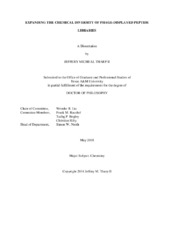| dc.description.abstract | Phage display is a widely-used tool for the directed evolution of peptide ligands from large combinatorial peptide libraries. A limitation of this technique arises from the lack of chemical diversity of the phage-displayed peptides. Being that they are genetically encoded, phage-displayed peptides are limited to the functional groups found in the twenty canonical amino acids. However, using orthogonal aminoacyl-tRNA synthetase/tRNA pairs, researchers have been able to greatly expand the genetic code to incorporate numerous non-canonical amino acids (ncAAs) bearing diverse chemical functionalities. In this thesis we utilize the technique of genetic code expansion to incorporate ncAAs into phage-displayed peptide libraries, thereby, greatly expanding their utility.
We begin by investigating the substrate spectrum of a rationally designed pyrrolysyl-tRNA synthetase (PylRS) mutant used for genetic code expansion. We demonstrate that, in addition to meta-, and para-substituted phenylalanine derivatives, this mutant can also facilitate the genetic incorporation of ortho-substituted phenylalanine in response to TAG codons in E. coli and in mammalian cells. We also report on the ability of one of the phenylalanine derivatives to serve as a fluorescent probe of protein local environment.
Next, we turn our attention to using PylRS to incorporate ncAAs in response to TAG codons in phage display libraries. To do this, we developed a method for constructing phage libraries in which every clone contains an in-frame TAG codon. Such “TAG-obligate” libraries overcome obstacles associated with libraries that contain both TAG and non-TAG clones. Using our TAG-obligate library, in conjunction with PylRS mutants, we demonstrate the genetic incorporation of lysine and phenylalanine derivatives into phage-displayed peptides. One lysine derivative, NƐ-butyryl-lysine, is a naturally occurring lysine posttranslational modification. We use the library containing this ncAA to select for peptide ligands of the lysine deacylase sirtuin 2. We demonstrate that peptides identified from this selection, when synthesized with a structural analog of NƐ-butyryl-lysine, NƐ-thiobutyryl-lysine, are potent inhibitors of sirtuin 2-catalyzed lysine deacylation.
In a final study, we report on the design and synthesis of a regiospecific, kinetically controlled, bis-electrophile for cyclizing phage-displayed peptides. We use this new compound to cyclize peptides on a phage-displayed library and screen the library against two model proteins. Future directions for this ongoing work are also discussed. | en |


